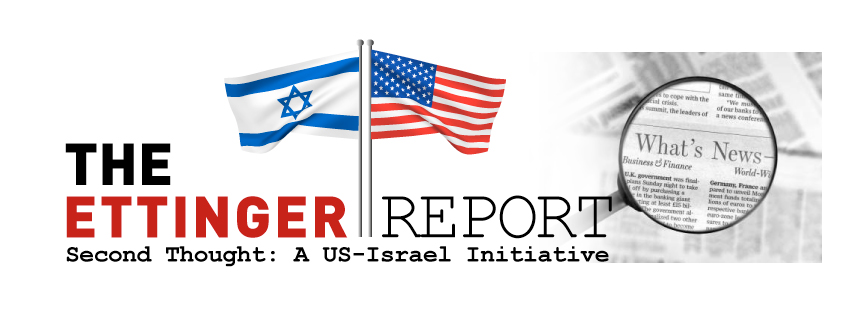
Yoram will be in the US in August and October/November,
2017, available for speaking engagements.
The US-Iran Syndrome: Leverage or Squander?
Ambassador (ret.) Yoram Ettinger, “Second Thought: US-Israel
Initiative”
July 7, 2017, http://bit.ly/2sTUpxL
Western leaders tend to sacrifice long-term, complex
national security strategic goals on the altar of short-term, easily-grasped
tactical gains. This is a derivative of flawed leadership and the fundamentals
of democratic political systems and societies: the pre-determined,
relatively-short political life-expectancy of leaders and legislators; the
centrality of public opinion; the reservations about conducting wars overseas;
the high-sensitivity to war casualties; etc.
For example, in 2003, the US focused on the clear and
present threat posed by Saddam Hussein, but downplayed its ripple effect on the
larger context, including the threats posed by the Ayatollahs of Iran and other
forms of Islamic terrorism. Thus, the US military toppled the repressive,
terroristic, imperialistic Sunni-Ba’ath regime of Saddam Hussein, and
transferred the helm to Iraq’s Shiites, who account for 50% of Iraq’s population,
compared to 30% Sunni and 20% Kurdish.
However, empowering Iraq’s Shiites frustrated and threatened
the senior Iraqi Sunni military, tribal and political personnel, driving them
to the folds of Sunni Islamic terrororganizations, such as ISIS, the Islamic
Army in Iraq, Al Qaeda Iraq and the Mujahidin Army of Iraq. Moreover, the devastation of Iraq – an
historically geostrategic counter balance to Iran - has dramatically upgraded
the regional and global power-projection of the Ayatollahs, paving the road to
their domination of Iraq. This has provided a tailwind to their predominance in
Syria and, increasingly, in Lebanon, intensifying regional volatility, and
posing a lethal threat to all pro-US Arab Sunni regimes. Thus, the spoils of a just US military
victory were snatched by an arch-enemy, the Ayatollahs.
In 2017, the US has intensified its war on ISIS in Iraq and
Syria, bringing ISIS to the verge of defeat.
However, a defeat of the Sunni ISIS triggers ripple effects, such as
bolstering the fortunes of two satellite regimes of Teheran: the Alawites in
Damascus and the Shiites in Baghdad. Therefore, the failure to leverage the
defeat of ISIS as a stepping-stone towards the toppling of the chief enemy, the
Ayatollahs, would upgrade the regional and global, destructive power-projection
of the “Death-to-America” Ayatollahs, whose machete is at the throat of all
pro-US Arab regimes.
The grand design of the Ayatollahs is to coalesce
territorial continuity from Iran in the Persian Gulf, through Iraq and Syria to
Lebanon (and its 30%-40% Shiite component) on the Mediterranean, proceeding to
topple the pro-US Sunni regimes in the Arabian Peninsula and the Persian Gulf,
Jordan and Egypt, gaining control over the paramount, strategic straits of
Hormuz and Bab-el-Mandeb, much of the Indian Ocean and the Red Sea, the Muslim
World and then the world at-large.
Since their rise to power in 1979, the agenda of the
Ayatollahs has been independent of – and drastically beyond - the Palestinian
issue, but for one cardinal issue: they are aware that a Palestinian state in
the mountain ridges of Judea and Samaria would dramatically erode the
power-projection of Israel (“the Little Satan”), which would deny the US (“the
Great Satan”) and its Arab allies a most effective beachhead in the Middle
East. The Palestinian issue has not been relevant to the Ayatollahs grand
design – which is based on a 1,400 year old Islamic ethos - nor to the Saudi
appreciation of Israel’s assistance in removing the Ayatollahs’ machete from
their throat.
Contrary to Western foreign policy establishments, which
profess negotiation and compromise with - and substantial concessions to – the
Ayatollahs, the latter’s school curriculum highlights the megalomaniacal,
supremacist, apocalyptic, terroristic, anti-US nature of the Ayatollahs, who
pose a clear and present threat to the US homeland and national security.
On May 24, 2017, Ayatollah Khamenei, Iran’s Supreme Leader,
told the graduates of Imam Hossein Military Academy: “the Greater Jihad as
steadfastness and defiance of the Arrogance Front [led by the USA]…must top the
agenda of the Islamic Revolution….” The
Ayatollahs consider the July 2015 nuclear agreement a reaffirmation of Western
vacillation, a tenuous, tactical agreement with “the modern-day-crusader,
arrogant, Great Satan,” to be abrogated as befits agreements concluded with
“infidels,” in accordance with the Quran and Muhammad’s legacy. Currently, the
Ayatollahs employ the North Korean venue to obtain nuclear mega-capability, in
order to remove the US mega-obstacle to the mega-goal of dominating the Persian
Gulf, the Middle East and the world.
The Ayatollahs, on the one hand, and compromise, moderation,
stability and peaceful-coexistence, on the other hand, constitute a classic
oxymoron. Hence, a regime-change in Teheran is a prerequisite for reducing
regional and global turbulence.
Moreover, while the opposition to the Ayatollahs is gaining
ground, their ruthless regime, and the passivity of the West during the 2009
attempted uprising, precludes a peaceful transition of power.
Will the US leverage – or squander - the current offensive
against ISIS, leveraging the tactical gain in order to score a strategic
victory against the Ayatollahs? Will the
US preempt – or react to – the Ayatollahs’ access to nuclear capability? Will
the US resurrect its independence of unilateral military action, highlighting
its own national and homeland security considerations, or will the US sacrifice
this on the altar of multilateralism, which yields the lowest common
denominator of geostrategic effectiveness? Will the US and Israel follow a
reality-based policy in removing the Ayatollahs threat, or will they be duped,
and stalled, by a false linkage between the Ayatollahs and the Palestinian
issue?

No comments:
Post a Comment